one more Piranesian daze: circus act
2000.05.15
In attempting to discern the possible reason or message manifested by the plan changes to the Circus of Caligula and Nero and to the Circus Agonalia, I began to think of these specific circuses and how they may or may not relate to the numerous other circuses delineated throughout the Ichnographia. Within the version of the Ichnographia that is presently widely published there are six circuses, the Circus Caji et Neronis, the Circus Agonalia, the Circus Hadriani, the Circus Domtiae, the Circus Flaminius, and the Circus Apollinaris. With only minor adjustments to length, each circus is delineated in a virtually identical fashion, and, moreover, each circus reflects an archaeologically correct circus plan. As already illustrated, the plans of the Circus Caji et Neronis and the Circus Agonalia within the University of Pennsylvania Ichnographia reflect more stylized, i.e., archaeologically incorrect, circus formations. Since all the circuses are identical in the widely published version of the Ichnographia, I then began to wonder, via transposition, whether all the circuses within the Penn Ichnographia were likewise identical there in the form of exhibiting plan changes. In all honestly, I had not noticed any plan changes to the circuses other than the Circus Caji et Neronis and the Circus Agonalia the two times I had seen the Penn Ichnographia prior, but nor did I have any pictorial hardcopy evidence that there are no other plan changes. Having worked with the Ichnographia for over ten years, if I have learned anything, it is that the Ichnographia, no matter how well you think you know it, continually maintains the uncanny ability to beguile. Therefore, it was necessary for me to once more return to the other Ichnographia.
Upon doing further research, i.e., going back to the University of Pennsylvania's Fine Arts Library to again scan the Ichnographia Campus Martius, more plan changes were indeed discovered, and, just as I had begun to suspect, the "change of plans" effected the Circus Hadriani, the Circus Domitiae, the Circus Flaminius, and the Circus Apollinaris. Thus, it is now evident that each of the major "changes of plan", between the Ichnographia Campus Martius that is widely published and the Ichnographia Campus Martius within the rare book collection at the University of Pennsylvania's Fine Arts Library, occur more or less exclusively within those buildings of the Ichnographia labeled "circus".
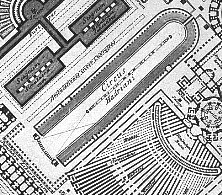 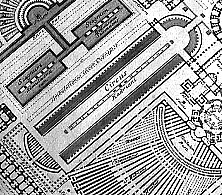
The plan above left is the Circus Hadriani as it appears within the commonly reproduced Ichnographia. Above right is the Circus Hardiani as it appears within the Ichnographia at the University of Pennsylvania.
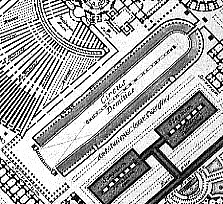 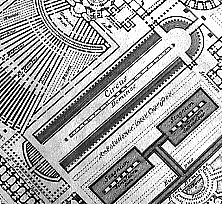
The plan above left is the Circus Domitiae as it appears within the commonly reproduced Ichnographia. Above right is the Circus Domitiae as it appears within the Ichnographia at the University of Pennsylvania.
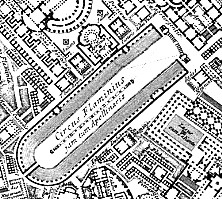 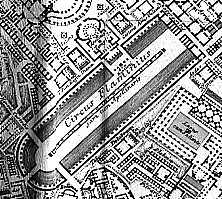
The plan above left is the Circus Flaminius as it appears within the commonly reproduced Ichnographia. Above right is the Circus Flaminius as it appears within the Ichnographia at the University of Pennsylvania.
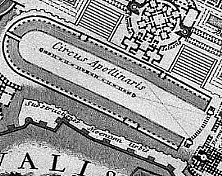 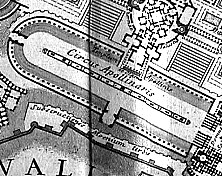
The plan above left is the Circus Apollinaris as it appears within the commonly reproduced Ichnographia. Above right is the Circus Apollinaris as it appears within the Ichnographia at the University of Pennsylvania.
As the above plan comparisons indicate, the newly discovered circus plans engage directly with their neighboring buildings, thereby rendering a connected contextualism and demonstrating a more integrated urban planning methodology. The circus plans of the commonly reproduced Ichnographia on the other hand, albeit archaeologically correct, do not engage their immediate surroundings, and appear as though literally afterthoughts. Beside the already mentioned questions as to what these changes might mean and which set of plans came first, or what Piranesi's intentions in making the changes might have been, there is now an additional question as to why the changes were specifically and only applied to the Campo Marzio's six circuses.
| |
a change of plan
2000.12.26
more of Piranesi's Campo Marzio
2001.07.01 09:05
You mentioned that you are not familiar with Piranesi's full Il Campo Marzio Dell'antica Roma publication. While its engravings are recently (and nicely) reproducted in both Wilton-Ely's and Ficacci's (Taschen) Piranesi: Complete Etchings, the texts that Piranesi wrote have to my knowledge never been republished (except for a facsimile publication of Il Camp Marzio by Borsi, 1972). The text is a history of the Campus Martius in both Latin and Italian, plus there is a list of extant ruins and a ' Catalogo', which is a bibliography of sorts -- what it does is list all the buildings that were in the Campo Marzio and matches them with their literary sources (both ancient and contemporary). Since I cannot read either Latin or Italian, the texts are for the most part inaccessible to me. The 'Catalogo', however, is for the most part discernable to me, and thus a great source into finding out what Piranesi was really up to when he 'reconstructed' (I refer reenacted) the Campo Marzio with the Ichnographia.
back to the Campo Marzio
2001.09.08 16:50
Hello John,
...getting back to the two states of the Ichnographia, here are some further thoughts and questions:
1. I believe the first state is the plan as it is NOT published in books today. If you look at the smaller and earlier plans of the Campo Marzio within the plates prior to the Ichnographia, you will see earlier plans of the Circus Flaminius the same as the Circus Flaminus plan within the first state Ichnographia. Furthermore, the aerial view the Circus Hadriani within the frontispiece corresponds in plan with the first state Ichnographia.
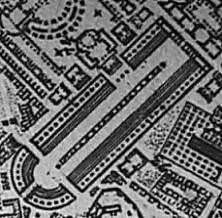 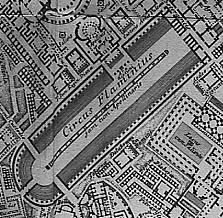
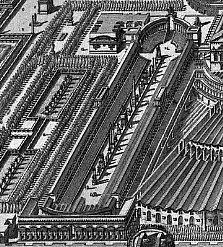 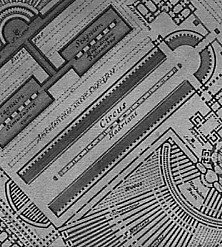
2. I think the circus delineations of the second state (which are all virtually identical to each other) are in fact delineations based on the Circus of Maxentius (rather than the Circus Maximus). This is somewhat significant in that (according to my research and interpretation of the Ichnographia as a double narrative relating Rome's inversion from pagan city to Christian city) Maxentius is exactly the ruler of Rome immediately prior to Constantine's Chistian efforts.
3. ...now knowledgable of the practice of damnatio memoriae, I wonder if Piranesi purposefully 'erased' portions of the Ichnographia as a reenactment of the damnatio memoriae practice, and, like some extant examples of dm inscriptions, if he then purposefully followed up with a palimpsest (of another plan) over the erasure.
4. I realized that I have yet to see an actual print version of the second state of the Ichnographia. All I've ever seen is an actual first state (1761) version. Do you know if you've seen an actual eighteenth cent. print version of the second state? Moreover, did you happen to make a trip to Rome to see which state the actual engraved plates are in? It is the current state of the plates that would surely identify the second state (that is, unless someone long ago altered a reproduction, and it happens to be an altered reproduction that's been printed in books all these years).
5. I also believe that it was indeed Piranesi that made the changes. My main reasoning here is that Piranesi was very likely the only person that could have made the changes with such dexterity.
As to Tafuri, I have documented so many cases within the Ichnographia that carried explicit meaning and message on Piranesi's part, that all of Tafuri's theorizing that the Ichnographia is indicative of and/or percursor to the modern meaninglessness of architectural form is plainly and emphatically wrong. What Tafuri obviouly never did, but definitely should have done, is to translate all the Latin labels that Piranesi applies to virtually all the plans of the Ichnographia. It is only through reading the labels and the planimetrics in combination that the full meaning of Piranesi's Campo Marzio comes through.
All the best,
Steve Lauf
Piranesi's Continual Double Theaters
2001.11.26
|